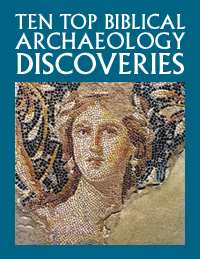
Mark Wilson describes a visit to Pella, an ancient city located in the Perean foothills of the Jordan River where Jesus’ followers sought refuge while escaping Jerusalem’s destruction.
Before writing my doctoral thesis two decades ago, the only Pella that I knew about was a small town in south central Iowa famous for its windows and doors. But in the course of my research, I discovered fascinating data about another Pella located in the Perean foothills of the Jordan River. In March I finally had the opportunity to visit the Pella located in northwestern Jordan.
Jesus, while looking over the temple mount in Jerusalem shortly before his death, prophesied that its beautiful stones would be thrown down within a generation. He warned that the residents should flee Jerusalem to the mountains when they saw the Roman armies surrounding the city. Jesus’ admonition is found in each of the Synoptic Gospels (Matthew 24:15–22; Mark 13:14–20; Luke 21:20–24). Perhaps Jesus visited Pella during his visit to the Decapolis (Mark 7:31) and Perea (Matthew 19:1; Mark 10:1), and recalling its secure location, cryptically referred to it in this prophecy. Eusebius’s Church History (3.5.3) recounts that the Jewish followers of Jesus heeded his warning and fled to Pella for safety before Jerusalem’s destruction. Birgil Pixner believes that, after the city’s destruction, they returned to Jerusalem to rebuild their Jewish-Christian synagogue on Mount Zion.*
Interested in Pella? Read “Excavating Ancient Pella, Jordan: Archaeology Investigates the Jerusalem Christians’ Escape to Pella” in Bible History Daily.
Today, Pella sits outside Tabaqat Fahl, twenty miles south of the Sea of Galilee. I was eager to see the geographical setting of the site to find out whether it qualified as a mountainous retreat. The University of Sydney has been conducting excavations at Pella since 1979. Remains from the Natufian through the Islamic period have been discovered – a period spanning over 10,000 years. But my interest was on structures that would have existed in the late first century C.E. However, few Roman buildings from that period remain because massive construction projects in the Byzantine period destroyed them. However, there are remnants of a Roman odeon, bathhouse and necropolis. Roman milestones found in the nearby hills show that roads directly connected Pella was with the important Decapolis city of Gerasa, modern Jerash.

Some scholars believe that the escape of the women’s offspring into the wilderness in Revelation 12:6, 14–17 uses mythological language to describe the flight of the Jerusalem church to Pella. While Revelation 12 is difficult to interpret, there does seem to be a historical basis for the events it describes. The dragon’s attempt to destroy the Jewish Christians, first in Zealot-controlled Jerusalem, and then while crossing the Jordan during the winter floods, came to naught. Instead, the Gentile churches of the Decapolis rescued and aided the Jewish-Christian refugees. With the Jerusalem church safe, the dragon next gave his attention to making war against the rest of the saints (12:17). While a bit fanciful, such a reconstruction must be taken into consideration, since others have little to commend them.
Become a Member of Biblical Archaeology Society Now and Get More Than Half Off the Regular Price of the All-Access Pass!
Explore the world’s most intriguing Biblical scholarship
Dig into more than 9,000 articles in the Biblical Archaeology Society’s vast library plus much more with an All-Access pass.

Although Pella is only in the foothills of the Transjordanian Mountains, the site seems to fulfill Jesus’ prophecy of a city of refuge. Standing in the upper basilica, the view across the Jordan Valley is spectacular. Mount Gilgal rises to the northwest, Beth-Shean/Scythopolis looms on the northeast. It was easy to imagine a weary company of refugees arriving in this city in the late 60s while attempting to survive the chaos falling upon Jerusalem.
Interestingly, the Pella in Iowa was founded in 1847 by 800 Dutch immigrants seeking religious freedom. Their minister Dominee Hendrik P. Scholte knew his church history and decided to name the new city after its Perean counterpart. Pella, old and new, still stands as a symbol of refuge and hope in a time of great crisis.
 Mark Wilson is the director of the Asia Minor Research Center in Antalya, Turkey, and is the host for BAS’s tours of Turkey. Mark received his doctorate in Biblical studies from the University of South Africa (Pretoria), where he serves as a research fellow in Biblical archaeology. He is currently Visiting Professor of Early Christianity at Regent University and Associate Professor Extraordinary of New Testament at Stellenbosch University. He leads field studies in Turkey and the eastern Mediterranean for university, seminary and church groups. He is the author of Biblical Turkey: A Guide to the Jewish and Christian Sites of Asia Minor and Victory through the Lamb: A Guide to Revelation in Plain Language. He is a frequent lecturer at BAS’s Bible Fests.
Mark Wilson is the director of the Asia Minor Research Center in Antalya, Turkey, and is the host for BAS’s tours of Turkey. Mark received his doctorate in Biblical studies from the University of South Africa (Pretoria), where he serves as a research fellow in Biblical archaeology. He is currently Visiting Professor of Early Christianity at Regent University and Associate Professor Extraordinary of New Testament at Stellenbosch University. He leads field studies in Turkey and the eastern Mediterranean for university, seminary and church groups. He is the author of Biblical Turkey: A Guide to the Jewish and Christian Sites of Asia Minor and Victory through the Lamb: A Guide to Revelation in Plain Language. He is a frequent lecturer at BAS’s Bible Fests.
* In the article “Church of the Apostles Found on Mt. Zion”, Bargil Pixner writes “The Judeo-Christian community in Jerusalem escaped this terrible catastrophe by fleeing to Pella in Transjordan and the countryside of Gilean and Bashan in expectation of the Parousia, the second coming of Christ.
When this did not occur and they realized that the time of Jesus’ return was not yet at hand, they decided to go back to Jerusalem to rebuild their sanctuary on the site of the ancient Upper Room—where the Last Supper had been held, where the apostles returned after witnessing Jesus’ ascension on the Mount of Olives and where Peter delivered his Pentecost sermon as recorded in Acts 2. It was this site on which they made their synagogue. They were free to do this because they enjoyed a certain religious freedom from the Romans (religio licita) inasmuch as they were Jews who confessed Jesus as their Messiah, and not gentile converts.”
Read “Church of the Apostles Found on Mt. Zion” as it appeared in Biblical Archaeology Review, May/June 1990.
This post originally appeared in Bible History Daily in July, 2012
Get more biblical Archaeology: Become a Member
The world of the Bible is knowable. We can learn about the society where the ancient Israelites, and later Jesus and the Apostles, lived through the modern discoveries that provide us clues.
Biblical Archaeology Review is the guide on that fascinating journey. Here is your ticket to join us as we discover more and more about the biblical world and its people.
Each issue of Biblical Archaeology Review features lavishly illustrated and easy-to-understand articles such as:
• Fascinating finds from the Hebrew Bible and New Testament periods
• The latest scholarship by the world's greatest archaeologists and distinguished scholars
• Stunning color photographs, informative maps, and diagrams
• BAR's unique departments
• Reviews of the latest books on biblical archaeology
The BAS Digital Library includes:
• 45+ years of Biblical Archaeology Review
• 20+ years of Bible Review online, providing critical interpretations of biblical texts
• 8 years of Archaeology Odyssey online, exploring the ancient roots of the Western world in a scholarly and entertaining way,
• The New Encyclopedia of Archaeological Excavations in the Holy Land
• Video lectures from world-renowned experts.
• Access to 50+ curated Special Collections,
• Four highly acclaimed books, published in conjunction with the Smithsonian Institution: Aspects of Monotheism, Feminist Approaches to the Bible, The Rise of Ancient Israel and The Search for Jesus.
The All-Access membership pass is the way to get to know the Bible through biblical archaeology.
The post Pella: A Window on Survival appeared first on Biblical Archaeology Society.


0 Commentaires